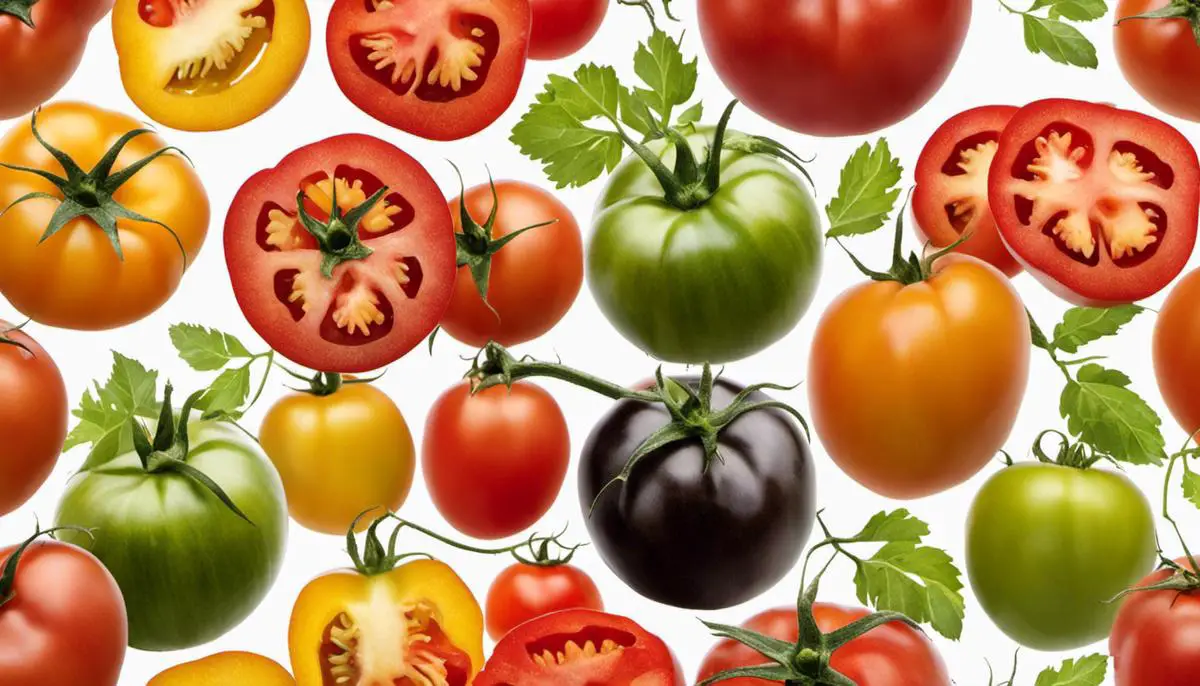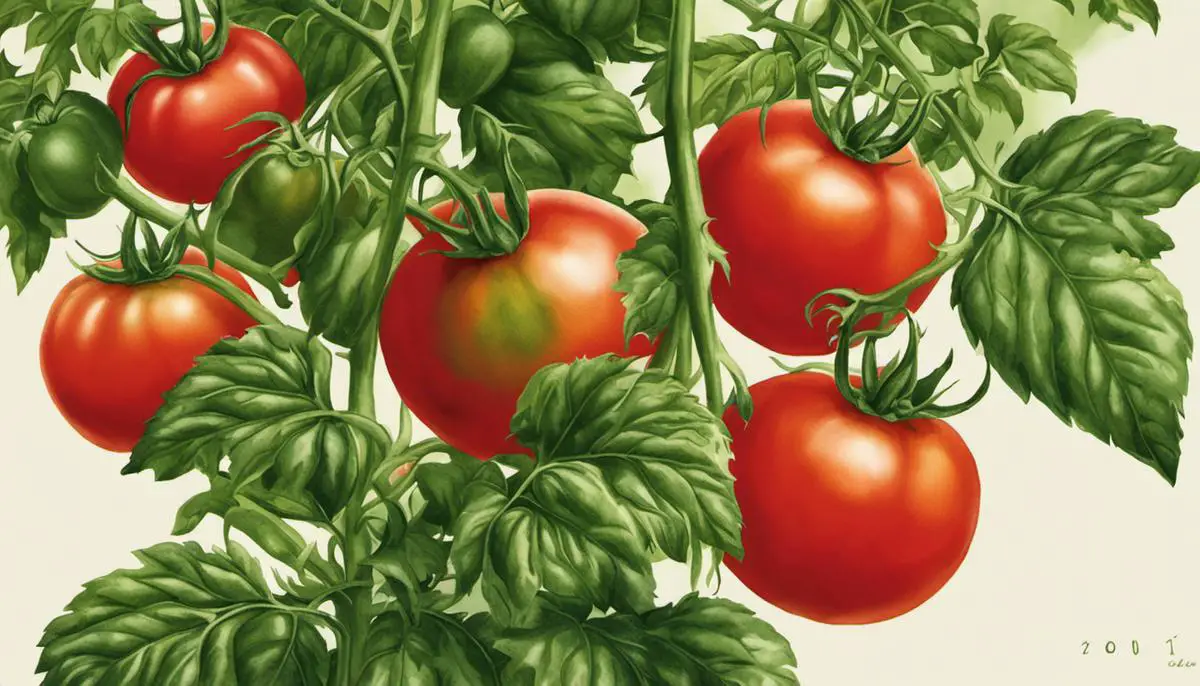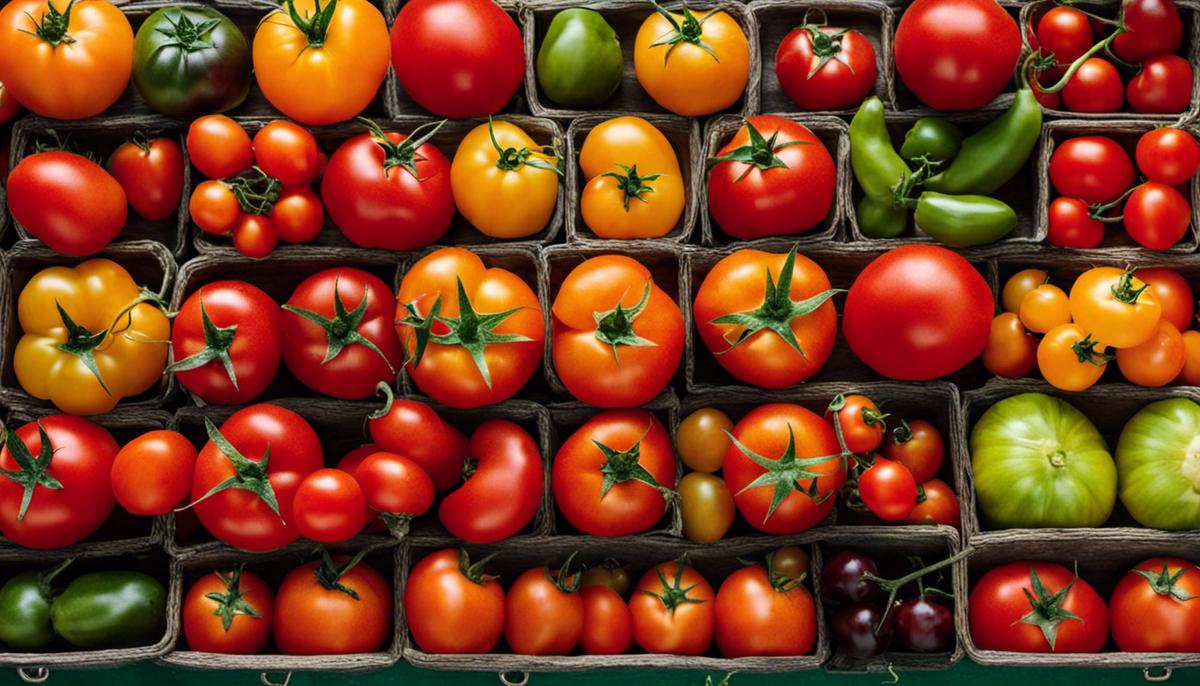Embarking on the journey of tomato gardening can be a rewarding experience offering the promise of sun-warmed, juicy tomatoes right at your fingertips. Whether you ponder about the perfect tomato variety to plant or seek advice for preparing the best soil, this guide is tailored to help beginners cultivate a successful tomato garden. Here, you’ll glean insights into the wide range of tomato options including determinate, indeterminate, cherry, roma, and beefsteak, and their suitability to different climatic conditions and personal preferences. Coupled with knowledge about soil amending, pH levels, drainage, and organic practices, you’ll be well-prepared to root your garden in the best possible foundation. Not stopping at just planting, we delve into vital caring and maintenance practices such as watering techniques, disease prevention, fertilization, staking, caging, and pruning to ensure a healthy harvest.
Choosing the Right Tomato Variety
The Fascinating World of Tomato Varieties for Beginners
Exploring the exciting realm of homegrown tomatoes? You’re in the right place! Tomato gardening isn’t just rewarding; it’s a pursuit of flavor, a slow dance of growth, and the multi-sensory delight of ripening fruits under warm sunshine. So, where does a beginner start in choosing from over 3,000 tomato varieties available worldwide? Let’s dive in with a selection of perfect starters: easy to grow and generously flavorful varieties.
Reader Poll: What online courses would interest you?
-
Roma Tomatoes: The Underrated Hero
First on the list, and possibly one of the most loved varieties, the Roma Tomato. They are the go-to variety for sauces and ketchups, thanks to their low moisture content and few seeds. As a determinate, or bushy variety, their growth habit is comparatively manageable, making them perfect beginners’ tomatoes.
-
Cherry Tomatoes: The Burst of Flavor
Cherry Tomatoes are absolutely delightful. Their small size makes them an excellent snack, a colorful addition to salads, or a cooking ingredient. They are incredibly generous when it comes to yield. Try the ‘Sunchocola’ or ‘Supersweet 100’ for a reliable and robust harvest.
-
Beefsteak Tomatoes: The King of Sandwiches
Who doesn’t love a juicy slice of Beefsteak Tomato in their summer burger or sandwich? These tomatoes are large, juicy, and come in a range of flavors depending on the variety. Try ‘Brandywine’, a classic heirloom Beefsteak loved for its exceptional flavor, or ‘Better Boy’, a tried and true variety renowned for its resistance to common tomato diseases.
-
Heirloom Tomatoes: The Garden Jewels
Heirloom tomatoes are non-hybrid tomatoes with seeds passed down through generations. They offer an assortment of unique sizes, shapes, colors, and flavors that can be more exciting than the usual red of hybrid tomatoes. Some of the interesting heirloom options for beginners are ‘Black Krim’, ‘Green Zebra’, and ‘Mortgage Lifter’.
-
Early Girl Tomatoes: The Speedy Crop
Are impatience and excitement virtues? The ‘Early Girl’ is your answer. Promising to be one of the fastest fruiting tomatoes, they produce juicy medium-sized fruits just 50-60 days after transplant, perfect when craving that early summer tomato blush.
When it comes to tomato gardening, patience, love, and a little bit of daily attention go a long way. Armed with knowledge and enthusiasm, any beginner can produce garden-fresh, sun-ripened tomatoes right at home. Remember, it’s more than just a hobby—it’s a journey, a ritual, and a triumph. Now, let’s get growing!

Proper Soil Preparation
Achieving Fertile Grounds: Essential Soil Preparation for Tomato Gardening
Delving into the art of tomato gardening, the crux of successful cultivation lies in the initial steps: soil preparation. Tomatoes are plants that demand a rich, properly balanced soil with good drainage for optimal yield. Not just any dirt will do – preparing soil for tomatoes requires meticulous care, blending the right constituents, analyzing structure, checking pH balance, and enriching with organic compost.
Start the journey by Choosing the Right Soil. Primarily, tomatoes thrive best in loamy soil that drains well. Excellent loam is a perfect balance of sand, silt, and clay – brown gold for amateur and professional gardeners. Ideal for tomato growth, this soil type retains necessary nutrients and water while providing adequate drainage and good aeration for roots.
Subscribe to our newsletter!
The second critical step is Checking The Soil’s pH Balance. Tomatoes prefer slightly acidic soils with a pH of 6.0 to 6.8. An inexpensive soil test kit from a local garden center can determine the pH. If your soil is too acidic (a pH below 6.0), apply garden lime to raise the pH. If it’s too alkaline (a pH above 7.0), integrate sulfur or organic composts like manure or sphagnum peat moss to lower the pH.
The third magic ingredient is Enriching with Organic Matter. Nutrient-hungry tomatoes require abundant organic matter in the soil. Compost, well-rotted manure, leaf mold, and green manures are all excellent choices for amending soils. These materials enrich the ground with a high amount of nutrients, improve soil structure, promote essential soil microorganisms and worms, and increase moisture retention.
The fourth aspect to focus on is Proper Drainage. Regardless of how rich a soil is, your tomato plants may still die from waterlogging or develop root diseases in poor draining soil. Heavy clayey soil might need some amending with sand and organic matter to improve its structure and enhance drainage.
It’s also crucial to Master the Art of Crop Rotation. It’s tempting to plant tomatoes in the same spot every year, especially after a successful harvest. However, this practice can deplete the soil’s nutrients and harbor disease-causing organisms. To prevent this, follow a basic crop rotation plan, shifting your tomato plants to a different spot each season.
Lastly, Don’t Forget to Rest the Soil. After the harvesting season, provide the soil with a much-deserved break. Cover it with a layer of organic materials—the “cover crop” method—or leave the land fallow over the winter. This resting period allows the earth to naturally recover its nutrients and recharge for the following growing season.
Of course, there might still be a bit of trial and error in this experiment called ‘tomato gardening,’ but learning these fundamental aspects of soil preparation can be a game-changer. Remember, the soil is a living entity that provides life to your plants; nurture it well, embrace its quirks, and in return, it’ll reward you with luscious, succulent tomatoes! But don’t stop here, continue expanding your knowledge, and be ready to get your hands dirty. Enjoy the journey, and happy gardening!

Caring and Maintaining the Tomato Plants
Most Essential Steps for Tomato Care and Maintenance
Imagine opening your backdoor to pick a fresh, sun-ripened tomato directly from the vine – just the aroma itself brings a feeling of satisfaction. To get to this moment though, proper care and maintenance of your tomato plants is essential. Let’s delve into the best ways of nurturing these versatile fruits to perfection.
First and foremost, ensure your tomatoes get sufficient sunlight. A tomato plant thrives in full sun, meaning it requires at least six to eight hours of sunlight a day. An ideal tomato garden spot benefits from early morning sun, which allows dew to dry quickly and helps prevent diseases.
Once your plants have been placed in their solar sanctuary, it’s time to consider watering. Regular watering is crucial. Keep in mind that a slow, deep watering is better than a quick sprinkle. Deep, thorough irrigation encourages roots to grow down into the soil, increasing their stability and providing them with better access to nutrients. However, don’t overwater them, or you risk drowning the roots.
Accompanying this, it’s recommended to water in the morning, when the air and soil are cool. This can decrease the chance of your tomato plants developing several diseases that are encouraged by high humidity or wet foliage. Not to mention, this helps the water to reach the roots without too much excess water lost to evaporation.
As your plants grow, it’s necessary to provide them support. And for that, staking or caging is recommended. Not only does it help prevent diseases by keeping the plants off the ground, but it also makes it easier to harvest the tomatoes when they are ripe.
Another significant aspect is pruning. Yes, your tomato plants need a haircut too! This not only helps your plants focus their energy on producing fruit but also improves air circulation, which can reduce disease problems. Pruning allows your plants to grow stronger and produce more tomatoes.
Finally, monitor for pests and diseases. Both can be detrimental to your tomato plants if not checked promptly. Aphids, hornworms, and spider mites are common tomato enemies. Encourage beneficial insects like ladybugs and spiders that will keep these pests in check. As for diseases, scout your plants regularly to catch any signs early and take necessary actions.
In conclusion, taking care of tomato plants may seem daunting at first, but don’t let that deter you! Once you get a grasp of it, these actions will become second nature. And the reward – succulent, home-grown tomatoes – is definitely worth the effort! Your love for tomato gardening will deepen with every tomato you nurture from seed to harvest. So, get out there, start gardening, and let your tomato plants flourish under your meticulous care!

After gaining a firm foundation regarding tomato varieties, soil preparation, and plant care, there’s every potential of a thriving garden with robust plants offering bountiful yields. Remember, gardening is more about practice than theory, so get your hands dirty, make mistakes, learn, and grow with your garden. By adapting to the needs of your plants, the climate, and the soil, you’ll steep in the joys of reaping what you sow. Let this be your compass in the world of tomato gardening, guiding you towards nature’s rewarding taste of success!

